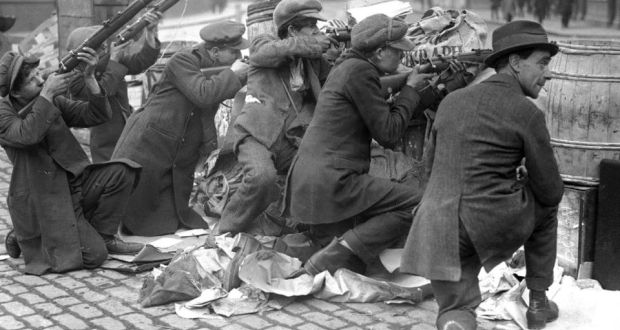The Republic of Ireland Act 1948 came into affect on April 18th 1949, seeing 26 counties leave the UK and creating the country of The Republic of Ireland.
Wars, Uprising and Part of the UK
For centuries Ireland and England had been fighting wars, generally following a pattern of English control of the island, followed by uprisings and attempts to remove the English from the land.
The harsh treatment of Irish people by what they saw as an invading force is one of the darker aspects of British and Irish history.
The Act of the Union on January 1st, 1801 declared Ireland to be part of the United Kingdom.

Land Issues
One of the biggest problems in Ireland after the Act of the Union was land ownership, with rich landlords (including absentee landlords living in England) charging high rents on farmers and tenants, keeping much of the nation poor. The Irish Land League was formed and through political pressure (and some violence) managed to get rents reduced.
However, there were attempts to suppress the Land League after the ‘Land Wars’. This only worked in inspiring the creation of the Irish National League, a new group that was interested in wider issues, including Irish independence.
Nationalists and Unionists
People living in Ireland also began to split into two groups based on religious lines: Irish Catholics, who generally wanted to have an independent Ireland, and Irish Protestants, who wanted to stay with the protestant UK (fearing that an independent Catholic Ireland was not in their interests).
Those who wanted independence were nationalists. Those who wanted to stay with the UK were Unionists. The arguments between these two sides would eventually split Ireland.
Irish War of Independence

By 1910 it looked as if Ireland would become independent through political means: nationalists held the majority of the political power in Ireland, and a Home Rule Act was being pushed through the British parliament. However, Unionists opposed the idea of independence, and the British Prime Minister amended the Home Rule Act, splitting the country to keep the Unionists happy.
World War 1 arrived and the Home Rule Act was suspended. This caused further problems: some of those who wanted Irish independence vowed to fight with the British and solve the issues after the war. Others saw this as the time to fight against the British and gain independence.

The Easter Rising of 1916 was an attempt at independence which the British crushed. Leaders were executed, and many people were arrested. The actions of the British army made the want for independence stronger. Around the same time, Britain tried to introduce conscription (forcing people to join the army) in Ireland in an effort to beat the Germans. This was also unpopular. An election was held in 1918. Outside of the Unionist north, 91% of seats in Ireland were won by Sinn Fein (the Irish Nationalist Party). Sinn Fein then declared its own government and called Ireland independent (although only the Soviet Union accepted Ireland as an independent country).

War finally arrived when Irish Nationalists – not working with the government – killed two British police officers. British police officers would be a target for much violence during Ireland’s troubles, and Britain sent in a division of its army nicknamed the ‘Black and Tans’.
The war would last for two years, ending in 1921. The UK agreed to let Ireland become a ‘free state’ – a part of the British Commonwealth, but run by itself (similar to Canada). However, 6 counties in the North were given the choice to leave the free state and stay with the UK; all 6 did this.
Moving Away from the UK and Independence
In 1937 a new constitution of Ireland was introduced, replacing ‘The Free State of Ireland’ with ‘Ireland’ (or ‘Eire’, in Irish) and creating the office of the Irish President. Ireland was basically self-governing, but still technically under the rule of King George.
World War II (1939-1945) slowed down Irish independence, but the Republic of Ireland Act was finally written in 1948, and came into effect on April 18th, 1949.
The Aftermath

Independence did not stop the violence in Ireland: many people believed that the 6 counties in the north should be part of Ireland, not the UK. A new version of the Irish Republican Army (IRA) – not supported by the Irish government – began a campaign of violence against British police officers in the country. Over the course of 30 years of bombing and fighting, over 3500 people died (over half civilians) and nearly 50 000 people were injured. Even when the IRA had a ceasefire, splinter groups continued bombing.
As well as the Nationalist/Unionist problem, religion was also a major division. The Republic of Ireland was about 90% Catholic, whilst Northern Ireland was Protestant. This division – coupled with the political lines – caused many incidents of violence.
It was only in the 1990s and 2000s that ‘The Troubles’ stopped. Northern Ireland took up a model of power sharing, allowing both Unionist and Nationalist politicians to be represented. Meanwhile, it also moved away from using the British-backed policing, and started its own police forces that represented both sides of Ireland. In exchange, Ireland dropped any demands for the 6 counties to be removed from the UK.